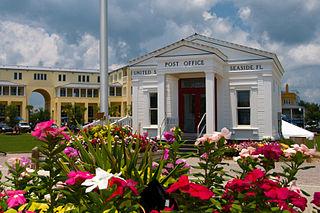
New Urbanism is an urban design movement that promotes environmentally friendly habits by creating walkable neighbourhoods containing a wide range of housing and job types. It arose in the United States in the early 1980s, and has gradually influenced many aspects of real estate development, urban planning, and municipal land-use strategies. New Urbanism attempts to address the ills associated with urban sprawl and post-Second World War suburban development.

The Hudson–Bergen Light Rail (HBLR) is a light rail system in Hudson County, New Jersey, United States. Owned by New Jersey Transit (NJT) and operated by the 21st Century Rail Corporation, it connects the communities of Bayonne, Jersey City, Hoboken, Weehawken, Union City, and North Bergen.
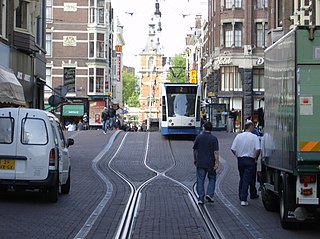
In urban planning, transit-oriented development (TOD) is a type of urban development that maximizes the amount of residential, business and leisure space within walking distance of public transport. It promotes a symbiotic relationship between dense, compact urban form and public transport use. In doing so, TOD aims to increase public transport ridership by reducing the use of private cars and by promoting sustainable urban growth.

West Side Avenue station is a station on the Hudson–Bergen Light Rail (HBLR) in the West Side neighborhood in Jersey City, New Jersey. Located on the east side of West Side Avenue, the station is the terminal of the West Side Avenue branch of the Hudson–Bergen Light Rail, with service to Tonnelle Avenue station in North Bergen. The station consists of a single island platform and a pair of tracks that end at the station. The station contains a pedestrian bridge over West Side Avenue to a small parking lot and bus stop on the west side of the street. The station is accessible to people with disabilities, with an elevator in the pedestrian overpass and train-level platforms. West Side Avenue station opened on April 15, 2000 as part of the original operating segment of the Hudson–Bergen Light Rail.
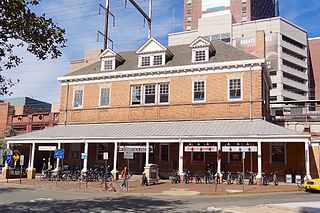
New Brunswick is an active commuter railroad train station in the city of New Brunswick, Middlesex County, New Jersey. The station services trains of New Jersey Transit's Northeast Corridor Line and Amtrak's Crescent, Keystone Service, Northeast Regional, and Palmetto. For New Jersey Transit trains, the next station to the southwest is Jersey Avenue, while the next station to the northeast is Edison. For Amtrak services, the next station southwest is Princeton Junction, the next station to the northeast is Metropark. The station consists of two handicap-accessible side platforms surrounding the four tracks.

Mixed use is a type of urban development, urban design, urban planning and/or a zoning classification that blends multiple uses, such as residential, commercial, cultural, institutional, or entertainment, into one space, where those functions are to some degree physically and functionally integrated, and that provides pedestrian connections. Mixed-use development may be applied to a single building, a block or neighborhood, or in zoning policy across an entire city or other administrative unit. These projects may be completed by a private developer, (quasi-) governmental agency, or a combination thereof. A mixed-use development may be a new construction, reuse of an existing building or brownfield site, or a combination.
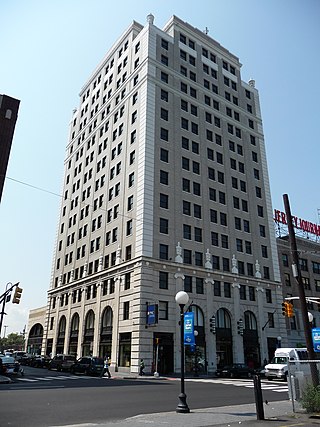
Journal Square is a business district, residential area, and transportation hub in Jersey City, New Jersey, which takes its name from the newspaper Jersey Journal whose headquarters were located there from 1911 to 2013. The "square" itself is at the intersection of Kennedy Boulevard and Bergen Avenue. The broader area extends to and includes Bergen Square, McGinley Square, India Square, the Five Corners and parts of the Marion Section. Many local, state, and federal agencies serving Hudson County maintain offices in the district.

Bayfront is an urban redevelopment project in Jersey City, New Jersey.

Hackensack River Greenway, once known as the Hackensack RiverWalk, a is partially constructed greenway along the Newark Bay and Hackensack River in Hudson County, New Jersey, United States.

In urban planning, walkability is the accessibility of amenities by foot. It is based on the idea that urban spaces should be more than just transport corridors designed for maximum vehicle throughput. Instead, it should be relatively complete livable spaces that serve a variety of uses, users, and transportation modes and reduce the need for cars for travel.

The Passaic–Bergen–Hudson Transit Project is a project under study by NJ Transit to reintroduce passenger service on a portion of the New York, Susquehanna and Western Railway (NYSW) right-of-way (ROW) in Passaic, Bergen and Hudson counties using newly built, FRA-compliant diesel multiple unit rail cars. Plans call for service to run from Hawthorne south through Paterson, east to Hackensack and then southeast to North Bergen, where it would join the Hudson-Bergen Light Rail (HBLR).

A pedestrian village is a compact, pedestrian-oriented neighborhood or town with a mixed-use village center. Shared-use lanes for pedestrians and those using bicycles, Segways, wheelchairs, and other small rolling conveyances that do not use internal combustion engines. Generally, these lanes are in front of the houses and businesses, and streets for motor vehicles are always at the rear. Some pedestrian villages might be nearly car-free with cars either hidden below the buildings, or on the boundary of the village. Venice, Italy is essentially a pedestrian village with canals. Other examples of a pedestrian village include Giethoorn village located in the Dutch province of Overijssel, Netherlands, Mont-Tremblant Pedestrian Village located beside Mont-Tremblant, Quebec, Canada, and Culdesac Tempe in Tempe, Arizona.

The West Side of Jersey City is an area made up of several diverse neighborhoods on either side of West Side Avenue, one of the city's main shopping streets. Parallel and west of Kennedy Boulevard, West Side Avenue carries two county route designations.

Healthy community design is planning and designing communities that make it easier for people to live healthy lives. Healthy community design offers important benefits:
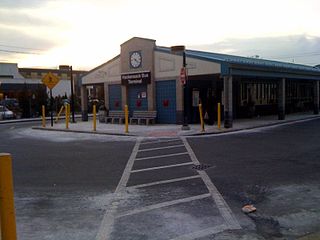
Hackensack Bus Terminal, also called the Hackensack Bus Transfer, is a regional bus station in downtown Hackensack, New Jersey, owned and operated by New Jersey Transit. The bus station was built in the 1970s and was extensively renovated in 2007 while starting in 2006. An outdoor central island boarding–disembarking area surrounds an indoor waiting room and ticketing facilities. Service from nearby bus stops travels to locations in Bergen, Passaic, Essex and Hudson counties as well as the Port Authority Bus Terminal and George Washington Bridge Bus Station in New York City. In October 2018, the Hackensack Transit Connector, servicing the bus terminal, the city's train stations, and the County Courthouse Complex, was initiated.

Bus rapid transit in New Jersey comprises limited-stop bus service, exclusive bus lanes (XBL) and bus bypass shoulders (BBS). Under the banner Next Generation Bus New Jersey Transit (NJT), the New Jersey Department of Transportation (NJDOT), and the metropolitan planning organizations of New Jersey (MPO) which recommend and authorize transportation projects are undertaking the creation of several additional bus rapid transit systems (BRT) in the state.

A Transit metropolis is an urbanized region with high-quality public transportation services and settlement patterns that are conducive to riding public transit. While Transit villages and Transit-oriented developments (TODs) focus on creating compact, mixed-use neighborhoods around rail stations, transit metropolises represent a regional constellation of TODs that benefit from having both trip origins and destinations oriented to public transport stations. In an effort to reduce mounting traffic congestion problems and improve environmental conditions, a number of Chinese mega-cities, including Beijing and Shenzhen, have embraced the transit metropolis model for guiding urban growth and public-transport investment decisions.

Robert Cervero is an author, consultant, and educator in sustainable transportation policy and planning. During his years as a faculty member in city and regional planning at the University of California, Berkeley, he gained recognition for his work in the sphere of urban transportation and land-use planning. His research has spanned the topics of induced demand, transit-oriented development (TOD), transit villages, paratransit, car sharing, and suburban growth.

Liberty Harbor is a neighborbood in Jersey City, New Jersey situated on the Morris Canal's Big Basin opposite Liberty State Park. The harbor was originally conceived in the 1970s to replace disused land and brownfields.



















